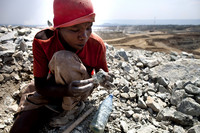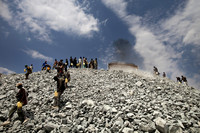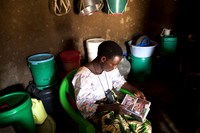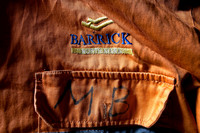By Cam Simpson | Bloomberg | Dec 23, 2010
Barrick Gold Corp.’s North Mara mine near the Tanzanian border with Kenya disgorges millions of pounds of waste rock each week, piled high around communities where almost half the people live on less than 33 cents a day.

Children in school uniforms scurry across the rubble to reach their classes. Women with water pails atop their heads skirt past the heaps. The piles grow as the longest bull market for gold in at least 90 years pushes Barrick, the world’s largest miner of the precious metal, to increase production.
Villagers, too, are hunting the ore on the North Mara land that their ancestors worked for decades, sometimes paying with their lives.
Security guards and federal police allegedly have shot and killed people scavenging the gold-laced rocks to sell for small amounts of cash, according to interviews with 28 people, including victims’ relatives, witnesses, local officials and human-rights workers.
“They are not arresting them or taking them to court,” said Machage Bartholomew Machage, a member of the Tarime District Council, the highest local government body. “They are just shooting them.”
At least seven people have been killed in clashes with security forces at the mine in the past two years, according to the 28 people interviewed. In at least four cases, police acknowledged the shootings in contemporaneous press accounts.
Killed and Wounded
The dead include Mwita Werema, a father of four who was killed one day after gold set another record price in October 2009; Chacha Nyamakono, who was one year from becoming the first in his family to complete a basic education; and Daudi Nyagabure, shot in February, who was eager to build a future for his pregnant wife.

Fifteen people were seriously wounded in the same period, according to the Legal and Human Rights Center, a human-rights group in the Tanzanian city of Dar es Salaam, and Machage, who was the district council vice chairman until August.
Toronto-based Barrick and African Barrick Gold Plc, which is 74 percent-owned by the Canadian miner, pay the Tanzanian government for federal police protection at the mine and employ private armed guards, according to company documents.
The violence at North Mara is a brutal dividend of gold prices that have risen almost threefold in the past five years to a record $1,431.25 on Dec. 7.
In written responses to questions about the situation, African Barrick said it frequently faces groups of intruders, often armed, who illegally enter the North Mara mine with the intent of stealing valuable ore.
Mine Trespassers
It also said some thefts, vandalism and other incidents are the result of organized crime, in part stoked by transients in the border region with Kenya.
People killed or injured after crossing into the mine area shouldn’t be considered small-scale miners because they were all trespassing and therefore acting illegally, said Andrew Wray, head of investor relations for African Barrick, in a Dec. 21 written response to questions.
“ABG categorically refutes any claim that any persons injured or killed were artisanal or small scale miners,” he wrote.
He declined to comment on specific cases, citing active or potential police investigations, except for one. He said allegations that mine security inflicted lethal injuries in that instance are “fundamentally untrue.” They were the result of a fight between intruders over stolen ore, he wrote.
Security Improves
Security incidents at the mine have “significantly declined” during the past two years despite record gold prices, Wray said. The company declined to comment on the number of people killed or injured by security forces in the past two years.
Barrick didn’t respond to written questions about North Mara, instead directing them to African Barrick. The Canadian company raised 581 million pounds, the equivalent of $872 million at the time, from the March 19 initial public offering in London of African Barrick.

Aloyce Tesha, a spokesman for Tanzania’s Ministry of Energy and Minerals, which oversees mining, declined to comment when presented with a list of the alleged killings at the mine. In an e-mail, he said the issues involved criminal investigations and referred questions to the police. Calls to the Inspector General of Police and the office of Tanzanian President Jakaya Kikwete were not returned.
Tensions Erupt
“The villagers are human beings and so they would like to get the minerals, and the policemen do not want them to get to the minerals,” Constantine Massawe, the commander of federal police forces at the mine and throughout the region, said in Swahili in a Nov. 11 telephone interview. “It’s not easy. If you tell them to leave, it’s not easy to get them to leave.” He declined to comment further.
During the reporting for this story, Tanzanian police arrested a photographer working for Bloomberg News on suspicion of trespassing at the mine site. He was jailed for a night and had his passport held for six days before he was freed without charges.

Security at the mine, where there are four open pit deposits, escalated after a riot in December 2008, African Barrick has said. A group of people invaded one pit after it had been blasted for ore. They burned $7 million of equipment and cost the mine several days of production. Police shot and killed one trespasser, Wray said.
Much about the killings since then is unknown, including their precise locations. In some areas popular with scavengers, few fences or signs mark where mine property ends and village life begins.
Firing Into Crowds
In several incidents, witnesses and contemporaneous press accounts quoting police indicated that officers fired into or over large crowds. In one killing, police told the government newspaper that shots were fired into the air after some miners tried to disarm officers.
According to Barrick, in some instances deaths and injuries were inflicted by other trespassers, not by the police or security. Barrick said some incursions go deep into its mining areas.
John McKay, a Canadian member of Parliament who sponsored legislation this year that sought to sanction mining companies for human-rights abuses abroad, said he wasn’t familiar with the North Mara mine and he declined to single out specific operators. Still, he said the profits delivered by gold’s high prices are causing a “moral blindness” at some companies.
Submitted by Kate Bomz.
Related posts:


I am tempted to suggest that electric fences can be used around mines to ward off thieves, but the truth is that nobody would steal if life was unproblematic… Unfortunately, Barrick is situated in a rural, poor, and struggling context.
why is it all about making the world feel sorry for the locals, the population was 1/10th of the size before mining started. persons are arriving day by day just to make an easy shilling.
most of the comments made hear relate only to the poor we local.
And what about the workers? some get hit with stones (resulting in medical treatment) Some have been hit with machetti , stabbed , even shot, so think about what the workers go thru , keep an open mind